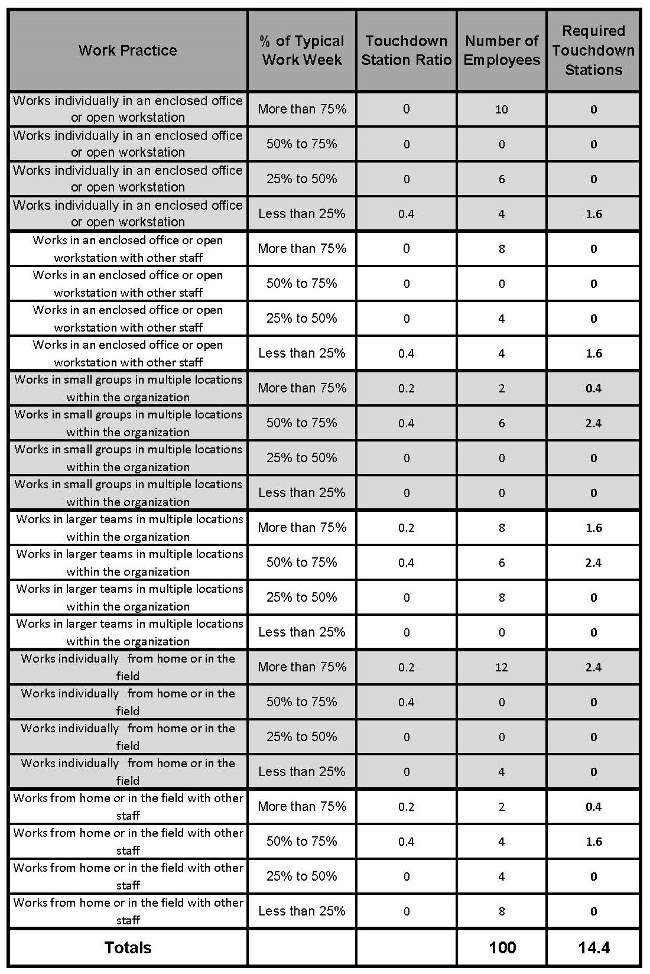Want to know how much open office space you’ll need per person in your new layout? This post guides you through where to start to calculate your office space needs.
This is a timely concern for architects, space planners, managers, and others involved in the rapid and ongoing transition to the open office. There are two aspects to answering the “how much open office space” question posed above; the underlying space concepts and the actual mathematical space calculations.
It Seems Like Just Yesterday: The Old Underlying Concepts
In the past, and by that, I mean just a few years ago, it was pretty simple to calculate the office space per person you needed for what I will term the “traditional office.” This office was principally comprised of enclosed private offices and open office workstations. A few support facilities such as conference, copy, and file rooms might be added on.
To calculate your overall space needs, conceptually, you just multiplied the number of employees whose work required a private office by the square foot standard for private offices. This was typically 150 square feet per person. Next, you multiplied the number of employees requiring a workstation by the workstation space standard, approximately 64 square feet per person. After adding some standardized square footage for the conference, copy, and file rooms, you multiplied the total amount of these spaces by a circulation factor, such as 1.3, to account for aisles and hallways. Voila, you had your total office space requirement.
If it were only that simple to calculate space requirements for today’s open office environments.
What Makes Today’s Open Offices Different? The New Underlying Concepts
In a word, sharing makes it more challenging to calculate space requirements for today’s open offices. Why? Each employee had a dedicated private or open office workstation in the traditional office. The number of offices, cubicles, and related space requirements were planned on a 1 to 1 ratio of workstations to employees.
In an open office space, the mobility allowed by today’s technology has led to practices such as teleworking from outside the office, as well as working from alternate locations within the office. This has correspondingly led to the need to calculate workspace requirements based on a wide range of workstations/seats to employees ratios other than the simple 1:1 of the past. But what are the appropriate ratios to use for your particular organization?
To further complicate matters, the currently desirable practice of employee collaboration has created entirely new categories of shared facilities to augment shared workspaces. These include office hubs, small huddle rooms, and larger huddle rooms or collaboration rooms. Again, what is the appropriate ratio of collaboration space to employees for your organization?
In addition, the shared open office environment creates a need for private spaces to replace the privacy lost by giving up dedicated offices and cubicles, e.g., the getaway booth. At the risk of sounding redundant, what is the appropriate ratio of getaway booths to employees to accommodate privacy for your organization?
After reviewing these current office planning concepts, you know why it is more challenging to calculate space requirements for today’s open office environments. So, how do you proceed to calculate office space per person requirements?
Mathematical Space Calculations: An Overview
To quantify the required number of workspace facilities, the number of employees engaged in the type and frequency of the work practice is not multiplied by the 1:1 ratio as was done for the traditional office. Instead, they are multiplied by less-than-1:1 ratios that denote the sharing of facilities. These ratios are based on the mobility levels derived from the workforce analysis described in the Change Your Office, Change Your Life article.
For example, I recently performed a workforce analysis and space calculations for a 100-person organization whose employees displayed a broad range of mobility levels. Forty-eight of these 100 employees were highly mobile and could all be accommodated with 15 touchdown stations, as calculated in the following work practices table. Here is an explanation of the columns in the table:
1. Work Practices – the predominant type of work the employee performs. These workstyles are determined via a survey, validated through focus groups, and place people into one of several categories: working either individually or collaboratively in a dedicated office, working in small groups or larger teams in multiple locations throughout the office, and working individually or collaboratively away from the office.
2. % of Typical Work Week – the percent of time employees spend working in a focused or collaborative work practice.
3. Touchdown Station Ratio – the percentage of a touchdown station required based on the time spent in work practice. Essentially, this is a sharing ratio for touchdown workstations.
4. Number of Employees – the number of employees that fall into each work practice by the percentage of time spent there.
5. Required Touchdown Stations – the touchdown station ratio multiplied by the number of employees equals the number of required touchdown stations.

When you consider that a shared touchdown station occupies only 25 net square feet compared to a private office at an average of 150 net square feet, or a dedicated workstation at an average of 64 net square feet, it is apparent that sharing due to employee mobility can have a significant impact on bottom line space requirements.
48 private offices require 7,200 square feet
48 dedicated workstations require 3,072 square feet
48 touchdown workstations require 1,200 square feet
15 touchdown workstations to accommodate 48 highly mobile personnel requires 375 square feet
Open Office Space Circulation Factor Calculations: Not your Father’s Narrow Hallways
In the traditional office of years gone by, the typical amount of space devoted to circulation included five to six feet wide hallways in private office areas and four to five feet wide aisles in open office workstation areas. As previously explained, this commonly resulted in a circulation factor of approximately 1.3 or an addition of 30% of the subtotal of office, workstation, and support spaces. These circulation spaces were claustrophobia-generating at best.
Today’s open office environments require much higher circulation factors. This is because circulation spaces are inherently an integrated component of the open office space. It can also be due to the desire to create a more pleasing and varied office environment. The advent of the office hub as a focal collaborative space is a prime example of the reason for this increase.
It would not be unreasonable for circulation factors (including space for collaborative office hubs) to be much higher, as high as 2.0, or addition of 100% of the subtotal of a private office, workstation, touchdown station, and support spaces.
Space Utilization Rates: Measuring the Results
When the total square feet of the office facility components, e.g., private offices, workstations, touchdown stations, and support space, is multiplied by the circulation factor, this produces the usable square feet measure for the office. The usable square feet measure often used in relation to the number of employees in the office to assess the space utilization rate efficiency level for the office - the usable square feet per person (usf/p).
Typical space utilization rates might range between 250 usf/p for an organization with a low degree of employee mobility to 150 usf/p (or less) for an organization with a high degree of employee mobility.
It should be recognized, however, that achieving lower utilization rates is much more feasible in larger organizations due to the inherent economies of scale realized across a larger office.
Putting the Math in Context: Do I Take a Top-Down or Bottom-Up Approach to Space Planning?
An additional and very basic question is whether a top-down or bottom-up approach is required. Essentially, “What are your goals?” in transitioning to an open office. Our recent post, One Size Doesn’t Fit All - What Are Your Office Space Transformation Goals?, may be a good place to begin considering this issue.
A top-down, quantitative approach is needed if the goal is to reduce your space footprint and save on operating costs. In this approach, a target for a total office size can be established in advance. Next, the number of workspaces and supporting collaborative and privacy facilities that will fit within this total space are established. Finally, employee work practices are developed that fit the open office that has been created. In this top-down approach, you fit the design to meet the open office space objectives.
Alternatively, if your goal is to develop a design to fit your organization's work practices – a bottom-up approach – you begin the process in an entirely different manner rooted in behavioral analysis. In this approach, you start with the functional objectives of your organization. Next, you consider the work practices needed to support these objectives. Finally, you develop a design sized to fit the work practices.
Today’s design professionals often add behaviorists and psychologists to their teams to address these change-laden preparatory issues. To learn more, check out Mindful Offices: Using Design Psychology to Create Better Workplaces, which provides some insight into this approach.
Sharing Equals Complexity
Whether your approach is top-down or bottom-up, you will unquestionably encounter entirely new concepts of space usage on which to base your move to a new open office space. These new workplaces based on sharing are more complex than traditional offices. And the process for planning them is commensurately more complex.
Given this complexity, it is essential to start by defining your goals, as discussed above, and methodically progress through determining work practices; calculating ratios for dedicated, collaborative, private, and shared spaces; and determining the amount of space and facilities needed to house your workforce. It is not rocket science, but you do have to calculate space!










.jpg)


.jpg)
.jpg)
-1.jpg)
.jpg)
.jpg)
.jpg)
.jpg)
.jpg)

